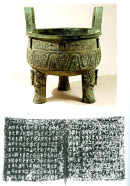The Zhou was originally a dependent state to the Shang Dynasty (17th-11t h century BC). It was based along the Weihe River in Shaanxi Province. It ruled much of the Wei and Yellow River valleys as well as portions of the Yangzi and Hanjiang River systems. According to legend the ancestor of the Zhou tribe was Di Ku. Zhou Dynasty was founded by King Wen, and solidified by his successor King Wu, who conquered the Shang Dynasty. King Wu later launched an attack on Muye, overthrew the Shang Dynasty and established the Zhou Dynasty. This is known as the Western Zhou in Chinese history. | 
|
Western Zhou Dynasty witnessed the prosperity in agriculture, economy, religion, education and art. Bronze metallurgy continued to develop, and reached its impressive peak. The Western Zhou Dynasty did not only inherit the assets of the Shang Dynasty, but also had their own innovations. The oracle-bone prediction was still popular in the Zhou. In the early Zhou, the ruler prohibited people from excessive drinking to put an end to the popular extravagant practices of the late Shang. The once common sight of drinking vessels in the Shang gradually became non existant.
Towards the end of the Western Zhou, the intensification of internal contradictions within the ruling class grew sharper. Uprisings in the kingdom shook the ruling class to its very foundations. In 771BC, King You, the last king of Western Zhou Dynasty was a tyrant who lost the support from the ruling class and the people. Finally, he was killed by the Quan Rong tribe, a minority group in northwestern China. This marked the end of Western Zhou Dynasty. King Ping, the son of King You, moved the capital eastward to Luoyi to avoid Quan Rong’s attack. This was the beginning of Eastern Zhou Dynasty.
|